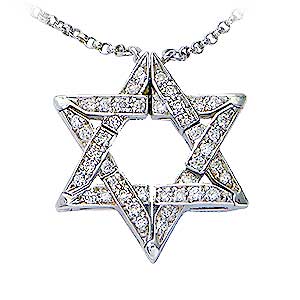Oh brother......
I guess snowflakes and six-petal roses are Satanic......
From Dartmouth's website:
http://www.dartmouth.edu/~matc/math5.geometry/unit5/unit5.html
Hexagon & Hexagram
 | Slide 5-15: Plate with Star of David
Keller, Sharon. The Jews: A Treasury of Art and Literature. NY: Levin Assoc. 1992 |
Hexagonal Tilings
Our next polygon is the hexagon, closely related to the equilateral triangle
The hexagon is a favorite shape for tilings, as in these Islamic designs, which are not regular tilings, because they use more than one shape.

Slide 5-9: Islamic Tiling Patterns
El-Said, Issam, et al. Geometric Concepts in Islamic Art. Palo Alto: Seymour, 1976. p. 54
But, as we saw, the hexagon is one of the three regular polygons will make a regular tiling.
An Illusion
The hexagon is sometimes used to create the illusion of a cube by connecting every other vertex to the center, forming three diamonds, and shading each diamond differently.
 | Slide 5-10: Basket Calter photo |
 | Slide 5-11: Pavement, Ducal Palace, Mantua Calter photo |
The Hexagon in NatureThe hexagon is found in nature in the honeycomb, and some crystals such as basalt, and of course, in snowflakes.
 | Slide 5-12: Snowflakes Bentley, W. A. Snow Crystals. NY: Dover, 1962. |
Six-Petalled RoseThe hexagon is popular in architectural decoration partly because it is so easy to draw. In fact, these are rusty-compass constructions, which could have been made with a forked stick.
Six circles will fit around a seventh, of the same diameter, dividing the circumference into 6 equal parts, and the radius of a circle exactly divides the circumference into six parts, giving a six petalled rose.
 | Slide 5-13: Moses Cupola. S. Marco, Venice
Demus, Otto. The Mosaic Decoration of San Marco, Venice. Chicago: U. Chicago, 1988. plate 60. |
Hexagon vs. HexagramConnecting alternate points of a hexagon gives a hexagram, a six-pointed star, usually called the Star of David,found in the flag of Israel.

Slide 5-14: Star of David on Silver bowl from Damascus.
Jewish Museum (New York, N.Y.), Treasures of the Jewish Museum. NY: Universe, 1986. p. 61
Solomon's Seal
The hexagrarn is also called a Solomon's Seal. Joseph Campbell says that King Solomon used this seal to imprison monsters & giants into jars.
 | Slide 5-17: The genii emerging.
Burton, Richard. The Arabian nights entertainments. Ipswich : Limited Editions Club, 1954. |
The U.S. Great Seal
 | Slide 5-20: Seal on Dollar Bill Calter photo |
The hexagrarn can also be viewed as two overlapping Pythagorean tetractys.
Joseph Campbell writes; In the Great Seal of the U.S. there are two of these interlocking triangles. We have thirteen points, for our original thirteen states, and six apexes: one above, one below, andfour to thefour quarters. The sense of this might be thalftom above or below, orftom any point of the compass, the creative word may be heard, which is the great thesis of democracy.- The Power of Myth. p.27Hexagonal Designs in ArchitectureHexagonal designs are common in ancient architecture, such as this church window in Quebec. | Slide 5-22: Church Window in Quebec Calter photo |
This marvelous design is at Pompeii. It is made up of a central hexagon surrounded by squares, equilateral triangles, and rhombi.

Slide: 5-23. Design at Pompeii
Calter photo

Slide 5-24: Design on Pisa Duomo
Calter photo
This hexagram is one of countless designs on the Duomo in Pisa.















